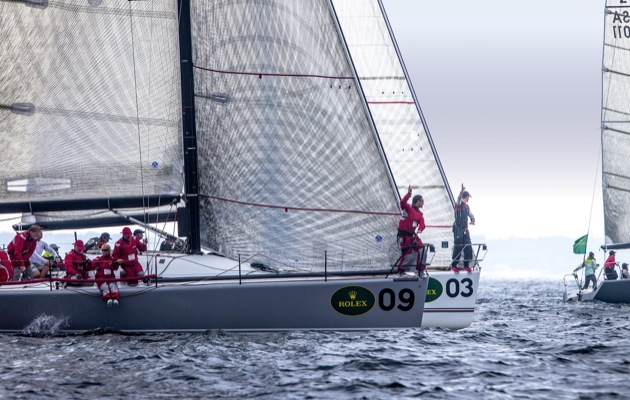Getting good starts is far from easy and the bowman’s role is crucial. Jonty Sherwill asked grand-prix bowman Matt Cornwell for his five best tips on giving the right signals
Five seconds to the start and the row of bows is accelerating towards the line. A boat to windward is early and obscuring your view of the start boat. The bowman signals for ‘full speed’, then runs aft and hits the rail. We’re off, there’s clear air and space below . . .
Stepping up to do ‘bow’ is to take on a multi-role, multi-skilled task. Clear communication is at the heart of all good sailing teams and during the prestart visual hand signals from the bowman, plus verbal input from the tactician and other team members, can help inform the helmsman of the distance to the line, proximity to other boats and whether to hold course, slow down, speed up, etc. Agreeing and understanding the visual signals is vital for a safe start.
Read our complete list of expert racing tips here
Although the pre-start may demand the highest level of concentration and precision, for the bowman it can be just the beginning of a race-long job list of headsail changes, gybes, spinnaker peels and trips aloft. On bigger yachts a run to the bow may also be needed to call a port/starboard dip or mark overlap and here the same hand signal code can be used.
The common hand signals used are:
A Raised fingers – one for each boatlength from the start line
B A nearly pinched finger and thumb – we are inside a boatlength and close to the line
C Fanning a flat palm – there is time to burn, slow down
D A clenched fist – hold this course
E Winding the arm – speed up, let’s get going
F Pointing to weather or leeward – a change of course in that direction is required
G Hand on back of head – I don’t have a good visual of the line, revert to the GPS if possible
H Swinging an arm low – we are clear to swing on the boat ahead, we are not overlapped
I Arm raised high – we are not clear to swing on the boat ahead, we are overlapped
- Time on distance. (Signals A, B, C, D) The bowman’s perspective of the start line can be a very useful tool to help your team hit the line on time and at pace. This becomes more relevant the closer you get to the start gun, particularly if the navigator is also feeding the helmsman with ‘time to burn’ from the GPS. Time on distance is purely a judgement and having a good feel for it means ‘getting your eye in’ and comes with practice. Encourage your team to do timed runs before racing starts whenever possible.
- Judgement. (Signals C, E, F, G) Conditions during the prestart can change quickly and have a large effect on the time it will take to get to the line. The bowman should have half an eye on the course ahead for any visible changes coming and try to have a good feel for the course conditions in general. For example, when starting on starboard tack, if the wind goes light or swings left it will take longer to get to the line; if the wind increases or swings right you will get there more quickly.
- Mid-line sag. (Signals A, B, C, D, H) The longer a start line is and the closer to the middle of it you are, the harder it is to judge your distance from the line. Usually a bowman will perceive the line to be closer than it actually is so identifying transits on land by looking along the start line before the start can be useful. That way the bowman can be more confident about distance from the line and the information he is giving to the back of the boat.Keep an eye on the committee vessel and pin end boat – if they adjust the line angle those transits will be lost.
- Signals. (All signals) The hand signals (left) are a generally accepted code, but each team may have its nuances and the bow and helmsman need to agree on these.But they can only provide so much information and often the vital communication needed comes from talking directly to the helm: how many seconds to burn (ie slow down), what’s happening with other boats, how close to the line you are, how many seconds before the gun can you ‘pull the trigger’ and: “We may have been over the line early, listen to the VHF”.
- Radio comms. (All signals) On boats of 50ft or less, the helmsman can usually hear you shouting, but bigger than that, particularly if you have a voice that doesn’t project well (like mine!) then radio communication can be very helpful. Wearing an earpiece and a mic can take some getting used to for the helmsman and the bowman, so the more time spent with the particular system you choose the better.I find it much better if I can’t hear the navigator relaying the GPS’s time to burn as it confuses my judgement more than it helps me, so I keep my earpiece volume low for the start.
This is an extract from a feature in Yachting World December 2014 issue













